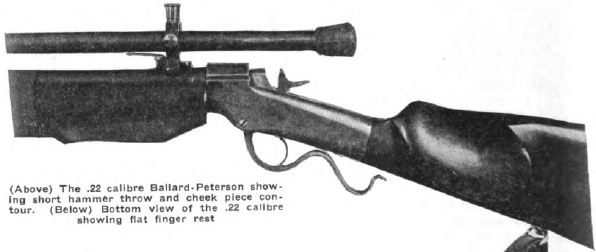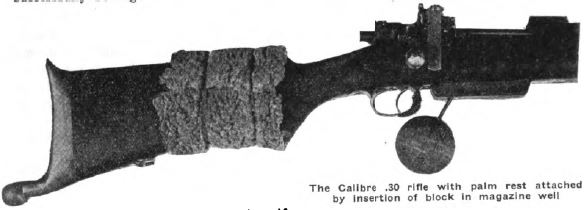
The Importance of Equipment
American Rifleman, vol 69, No. 19 June 15, 1922 – page 6-7
The Importance of Equipment
By W. R. Stokes
ONE of the undoubted prerequisites to becoming a “heavy hitter” in the rifle game is a thorough appreciation of the fact that the most skilled shots would perform little better than the average shooter if obliged to use his “average" equipment. From this hypothesis it cannot successfully be argued that the “average” shot would necessarily become a star if given the finest of equipment, but both reason and actual experience have clearly established the conclusion that the first rank among the stars of Rifledom is strictly unattainable without the aid of the very best equipment procurable.
And it may further be said that many a phenomenal performance by an acknowledged master of the rifle is due not, as may be generally supposed, so much to his brilliant skill as a holder as to the fact that he has made some superfine or novel improvement in his equipment, or has devoted an unusual amount of care and attention to every detail of the purely mechanical side of his preparations for firing.
These truths have, through the often bitter experiences that have tried the soul of every rifleman who has followed match shooting, been vividly recognized by the writer for some time past, and from first hand personal observation he can say that this, probably more than any other single factor, will speed the progress of a match shooter.
Because all this is pretty much the common knowledge of thoughtful riflemen everywhere, the writer submits for inspection the accompanying photographs and descriptions of his two finest and favorite rifles, about which there are several rather unusual features which are believed to be positive factors in the building up of good scores.
Cal. .22 Rifle for Use in All N. R. A. Small Bore Events

Description:
The action is an old Ballard, single trigger, refinished by Peterson of Denver. The barrel, made by Peterson, is 28" long, moderately heavy, and chambered for the .22 L. R. cartridge. The fore-end and butt-stock are of special design, made by myself to my measure. The rifle complete weighs 9 lbs. 15 ozs.
Special Features:
Hammer-fall shortened so that hammer falls only 3/8 " before striking firing pin.
Cheek rest not of the ordinary flat or merely side-hollowed type, but hollowed deep into and across top of comb, permitting support for a greater area of the face and increasing the aid given by the neck and face to steady holding.

Platform under fore-end to give support to tips of all fingers of the left hand in firing in the standing position. Tapped for palm rest base.
Fore-end hollowed out inside to permit insertion of bird-shot to increase weight when increased weight is allowed. Line of sighting with iron sights built up very high by block under front sight and use of long-stemmed rear sight, in order to have the high comb of the stock seem equally comfortable whether iron sights or ’scope be used; also aids in detecting “cant" of the rifle.

Large and smoothly rounded fore-end for comfortable grip. Fore-end and butt-plate wrapped with fresh tire-tape prior to match shooting in order to prevent slipping.
Large rubber cap, with small aperture, placed over rear end of ’scope to cut down size of ’scope field and to give a heavy and clearly defined black ring around the field. (Rubber tip of a crutch used for this purpose.)
Cal. .30 Rifle for Use in Free Rifle Events or N. R. A. Long Range Matches

Description:
The action is a Springfield. The barrel was specially taper-bored by the Springfield Armory, and refinished by Sergt. Blade, U. S. M. C. It is 24" long. The stock was made by Sergt. Blade, U. S. M. C. Butt-plate and palm rest were made by myself. The rear sight is a Lyman No. 48 and the front sight a special aperture type. With heavy butt-plate the rifle weighs 15 lbs.; without it, 11 ¾ lbs.
Special Features:
Double set triggers, made by a. German gunsmith after a pattern by Neidner.
Cocking piece knob cut off to speed up travel of striker.
Sheepskin cheek pad on very high comb.
Finger buffer on front of trigger guard.
Pistol grip with checkering.

Palm rest attached to block inserted in magazine after removal of the floor plate; note that the ball is situated well back, so that the shooter’s left forearm will not be inclined forward when he grips the ball in the firing position, but will be practically perpendicular, thus eliminating much strain on the muscles on the inside of the forearm. Butt-plate of bronze, weighing ¾ lbs., balances the heavy barrel and is of a special design adapted for use in any of the firing positions with almost equal facility and comfort.
Unusual weight of the rifle is great aid to steady holding, especially in the standing position, and is found not to be so excessive as to produce undue muscular strain. Front sight of the aperture type materially decreases possibility of optical inaccuracies in sighting. Ring and stem of the aperture are thick, to give strength and to add to clearness of definition in sighting.